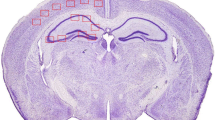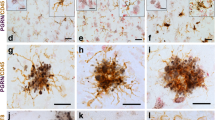Abstract
Highly phosphorylated τ protein is the main component of paired helical filaments (PHF), which comprise the neurofibrillary tangles (NFT) in some neurons of patients with Alzheimer disease (AD). Glycogen synthase kinase 3 (GSK3) phosphorylates τ in vitro at several sites also found to be phosphorylated in PHF-τ, τ is phosphorylated at these sites in both AD and normal control (NC) brains, although the extent of phosphorylation is far greater in τ from AD. If GSK3 levels are increased in AD, then τ phosphorylation and perhaps PHF formation may occur. To quantify GSK3, blots of AD and NC brain supernatant and particulate fractions were probed with antibodies to GSK3. In particulate fractions of AD compared to NC, GSK3α immunoreactivity did not increase, but in fact, decreased 40%, and GSK3β immunoreactivity decreased 30%. GSK3α and GSK3β levels correlated well with each other. GSK3 levels correlated negatively with numbers of NFT.
Similar content being viewed by others
References
Baum L., Seger R., Woodgett J. R., Kawabata S., Maruyama K., Koyama M., Silver J., Saitoh T. (1995) Overexpressed tau protein in cultured cells is phosphorylated without formation of PHF: implication of phosphoprotein phosphatase involvement. Mol. Brain Res.34, 1–17.
Coleman P. D., Kazee, A. M., Lapham L., Esking T., and Rogers K. (1992) Reduced GAP-43 levels are associated with increased neurofibrillary tangle density in the frontal association cortex (area 9) in Alzheimer’s disease.Neurobiol. Aging 13, 631–639.
Drewes G., Lichtenberg-Kraag B., Doring F., Mandelkow E. M., Biernat J., Goris J., Dorée M., and Mandelkow E. (1992) Mitogen activated protein (MAP) kinase transforms tau protein into an Alzheimer-like state.EMBO J. 11, 2131–2138.
Goedert M., Cohen E. S., Jakes R., and Cohen P. (1992) p42 map kinase phosphorylation sites in microtubule-associated protein tau are dephosphorylated by protein phosphatase 2A1.FEBS Lett. 312, 95–99.
Hanger D. P., Hughes K., Woodgett J. R., Brion J., and Anderton B. H. (1992) Glycogen synthase kinase-3 induced Alzheimer’s disease-like phosphorylation of tau: generation of paired helical filament epitopes and neuronal localisation of the kinase.Neurosci. Lett. 147, 58–62.
Iimoto D., Masliah E., DeTeresa R., Terry R. D., and Saitoh T. (1990) Aberrant casein kinase II in Alzheimer’s disease.Brain Res. 507, 273–280.
Iqbal K., Alonso A., Gong C., Khatoon S., Kudo T., Singh T., and Grandke-Iqbal I. (1993) Molecular pathology of Alzheimer neurofibrillary degeneration.Acta Neurobiol. Expt. 53, 325–335.
Ishiguro K., Takamatsu M., Tomizawa K., Omori A., Takahashi M., Arioka M., Uchida T., and Imahori K. (1992) Tau protein kinase I converts normal tau protein into A68-like component of paired helical filaments.J. Biol. Chem. 267, 10,897–10,901.
Ishiguro K., Shiratsuchi A., Sato S., Omori A., Arioka M., Kobayashi S., Uchida T., and Imahori K. (1993) Glycogen synthase kinase 3β is identical to tau protein kinase I generating several epitopes of paired helical filaments.FEBS Lett. 325, 167–172.
Jin L.-W., Masliah E., Iimoto D., DeTeresa R., Mallory M., Sundsmo M., Mori N., Sobel A., and Saitoh T. (1996) Neurofibrillary tangle-associated alteration of stathmin in Alzheimer’s disease.Neurobiol. Aging 17, 331–341.
Ledesma M. D., Correas I., Avila J., and Diaz-Nido J. (1992) Implication of brain cdc2 and MAP2 kinases in the phosphorylation of tau-protein in Alzheimer’s disease.FEBS Lett. 308, 218–224.
Mandelkow E. M. and Mandelkow E. (1993) Tau as a marker for Alzheimer’s disease.Trends Biochem. Sci. 18, 480–483.
Mandelkow E.-M., Drewes G., Biernat J., Gustke N., Van Lint J., Vandenheede J. R., and Mandelkow E. (1992) Glycogen synthase kinase-3 and the Alzheimer-like state of microtubule-associated protein tau.FEBS Lett. 314, 315–321.
Matsuo E. S., Shin R. W., Billingsley M. L., Van deVoorde A., O’Connor M., Trojanowski J. Q., and Lee V. M. (1994) Biopsy-derived adult human brain tau is phosphorylated at many of the same sites as Alzheimer’s disease paired helical filament tau.Neuron 13, 989–1002.
Morishima M. and Ihara Y. (1994) Posttranslational modifications of tau in paired helical filaments.Dementia 4, 282–288.
Okazaki T., Wang H., Masliah E., Cao M., Johnson S. A., Sundsmo M., Saitoh T., and Mori N. (1995) SCG10, a neuron-specific growth-associated protein in Alzheimer’s disease.Neurobiol. Aging 16, 883–894.
Plyte S. E., Hughes K., Nikolakaki E., Pulverer B. J., and Woodgett J. R. (1992) Glycogen synthase kinase-3: functions in oncogenesis and development.Biochim. Biophys. Acta 1114, 147–162.
Price D. L. and Sisodia S. S. (1994) Cellular and molecular biology of Alzheimer’s disease and animal models.Annu. Rev. Med. 45, 435–446.
Roder H. M. and Ingram V. M. (1991) Two novel kinases phosphorylate tau and the KSP site of heavy neurofilament subunits in high stoichiometric ratios.J. Neurosci. 11, 3325–3343.
Selkoe D. J. (1991) The molecular pathology of Alzheimer’s disease.Neuron 6, 487–498.
Steiner B., Mandelkow E., Biernat J., Gustke N., Meyer H. E., Schmidt B., Mieskes G., Söling H. D., Drechsel D., Kirschner M. W., Goedert M., and Mandelkow E. (1990) Phosphorylation of microtubule-associated protein tau: identification of the site for Ca2+-calmodulin dependent kinase and relationship with tau phosphorylation in Alzheimer tangles.EMBO J. 9, 3539–3544.
Sutherland C., Leighton I. A., and Cohen P. (1993) Inactivation of glycogen synthase kinase-3β by phosphorylation: new kinase connections in insulin and growth-factor signalling.Biochem. J. 296, 15–19.
Takashima A., Noguchi K., Sato K., Hoshino T., and Imahori K. (1993) Tau protein kinase I is essential for amyloid β-protein-induced neurotoxicity.Proc. Natl. Acad. Sci. USA 90, 7789–7793.
Trojanowski J. Q. and Lee V. M. (1994) Paired helical filament τ in Alzheimer’s disease: the kinase connection.Am. J. Pathol. 144, 449–453.
Trojanowski J. Q., Schmidt M. L., Shin R. W., Bramblett G. T., Rao D., and Lee V. M. (1993) Altered tau and neurofilament proteins in neuro-degenerative diseases: Diagnostic implications for Alzheimer’s disease and Lewy body dementias.Brain Pathol. 3, 45–54.
Yang S.-D., Song J.-S., Yu J.-S., and Shiah S.-G. (1993) Protein kinase FA/GSK-3 phosphorylated τ on ser235-pro and ser404-pro that are abnormally phosphorylated in Alzheimer’s disease brain.J. Neurochem. 61, 1742–1747.
Author information
Authors and Affiliations
Additional information
The authors dedicate this article to the memory of Tsunao Saitoh, who died May 7, 1996.
Rights and permissions
About this article
Cite this article
Baum, L., Hansen, L., Masliah, E. et al. Glycogen synthase kinase 3 alteration in alzheimer disease is related to neurofibrillary tangle formation. Molecular and Chemical Neuropathology 29, 253–261 (1996). https://doi.org/10.1007/BF02815006
Received:
Revised:
Accepted:
Issue Date:
DOI: https://doi.org/10.1007/BF02815006




